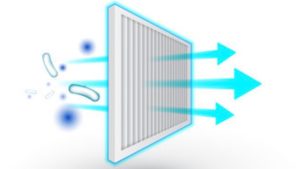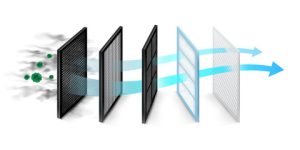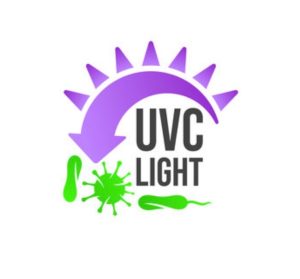With many countries, such as England and Germany, choosing to re-impose stringent lockdowns amidst a third wave of coronavirus infections, the incentive for businesses to find alternative ways to continue operating is higher than ever. Given that mask-wearing and social distancing are less viable in winter temperatures, the question of indoor air purification presents itself as an enticing offer for businesses that typically rely on crowded indoor spaces, which carry a high risk for the spread of COVID-19 through aerosolization and direct contact.

Many big manufacturers of air purifiers, such as Philips, Molekule and Dyson, have been capitalizing on this trend and marketing their products as effective against airborne pathogens.
Alongside these larger companies, many smaller start-ups have sprung up with claims of new technology that is uniquely suited to protect against airborne viruses, such as COVID-19.
Policy makers, scientists and business owners face two important questions: How effective are air purifiers against COVID-19? And, can they really be employed as an effective and efficient measure to allow normal, indoor operation of businesses and services?
Importantly, the EPA’s current COVID protocol states that air purifiers can be used effectively alongside other best practices, but are not to be relied on as a single defense against the virus.
In the media, experts acknowledge that air purifiers might reduce chances of infection by an additional fifty percent, but are quick to point out that this number drops precipitously if they are not used in tandem with masks. This means that, while air purification may increase the safety of dining inside or going to the theater, they can’t be relied on to return public activity to total normalcy.
Despite the limitations, air purifiers certainly present a promising option to be added to the line of defense against COVID, and are a method that can be implemented quickly and on various scales.
Air circulation and recharge is one of the most important measures to taken in populated, indoor environments, and notably one that many restaurants are completely ill-equipped to meet, despite lax indoor dining regulations in many countries and states. Air purifiers, which can be easily implemented as portable units or retrofitted into existed HVAC systems, are a viable remedy for this particular issue.
Of course, this is only true of air purifiers that are properly equipped to cleanse viruses from the air. The following are technologies that, according to experts and current media, appear to be the most effective in regards to the coronavirus and other viruses.
HEPA Filters
HEPA filters are the most widespread and traditional form of air purifier that is effective against viruses. These filters have about a 99% efficiency rate when it comes to removing viruses 0.3 microns in diameter, and are even more effective at removing viruses that are larger and smaller, down to 0.1 micron in diameter. These filters are also effective at removing dust, dander and pollen from the environment, an attribute that has long made them popular for home air purifying units. These filters are recommended by the EPA.

UVC Technology
As opposed to filtration, UVC technology, when used in air purifiers, is a method of actually sanitizing and killing the viral load that is captured. While HEPA filters will prevent a pathogen from circulating in the air, these pathogens end up trapped within a filter that needs removal. While this has not been shown to increase risk of virus transfer, UVC light has the added capability of eliminating all possible remnants of viral load. UVC light purifiers typically rely on a filter that slows down pathogens enough for them to be eliminated by UVC exposure.
Photocatalysis
Photocatalysis is the most novel purifying technology, and also uses UVC light as a component. Unlike traditional UVC purifiers, this newer variety does not rely on a filter that needs to be changed, which is a significant advantage when it comes to wide scale implementation, as it requires less maintenance and does not run the risk of operating less effectively because of unchanged filters. Instead of a filter, this technology uses a matrix coated with chemicals that slows down passing pathogens and bolsters the efficiency of UVC light as a sanitizing agent.
Implementation
While all three of these technologies are believed to be effective against viruses, they cannot be relied without proper implementation. As mentioned above, this means that it is crucial that purifiers using filters are maintained regularly. Additionally, it means the air filtration power of purifiers needs to match the capacity of the room.
Experts recommend “four to six air changes per for indoor spaces,” meaning that all the air in a space will need to be filtered every fifteen minutes for this technology to be effective against airborne viruses, including COVID-19.
Air purifiers also need to be in a room where air is effectively being circulated in order to function optimally. While some purifiers, like those made by Dyson, are capable of circulating air and purifying it simultaneously, most purifiers will simply purify a small area in the immediate vicinity of the purifying unit if air is not circulated properly.
While there has not yet been enough time to conduct suitable scientific studies on the efficacy of air purifiers as protective measures against the novel coronavirus, the available knowledge seems to clearly suggest that they can be used effectively as a layer in a “Swiss cheese model” of defense. In a time when quick action is crucial and often left undone, air purifiers may prove to be a valuable tool in the remaining months of the pandemic.
Sources Cited:
- https://www.webmd.com/lung/news/20201103/can-portable-air-cleaner-protect-you-from-covid
- https://www.nytimes.com/wirecutter/blog/can-hepa-air-purifiers-capture-coronavirus/
- https://www.npr.org/sections/goatsandsoda/2020/09/04/908896132/coronavirus-faq-is-it-a-good-idea-to-buy-an-air-cleaner-for-my-home
- https://www.consumerreports.org/air-purifiers/molekule-air-purifier-review/https://www.nytimes.com/wirecutter/blog/watchdog-rejects-molekule-air-purifier-claims/
- https://www.epa.gov/coronavirus/air-cleaners-hvac-filters-and-coronavirus-covid-19
